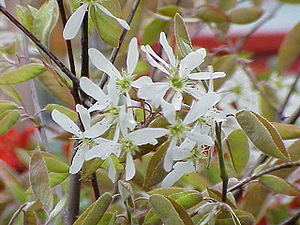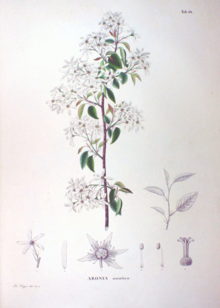Rock pears
| Rock pears | ||||||||||||
|---|---|---|---|---|---|---|---|---|---|---|---|---|

Amelanchier lamarckii ( Syn.Amelanchier grandiflora ) |
||||||||||||
| Systematics | ||||||||||||
|
||||||||||||
| Scientific name | ||||||||||||
| Amelanchier | ||||||||||||
| Medic. |
The plant genus rock pear ( Amelanchier ) belongs to the "apfelfrüchtigen" pome fruit crops (Pyrinae) in the family of the rose family (Rosaceae).
description


Amelanchier species are deciduous shrubs or small trees . The alternate leaves arranged on the branches are divided into a petiole and a leaf blade. The simple leaf blades are often tomentose. The leaf blade halves rest in the bud position folded conduplicatively - similar to the tulip tree . The leaf margins are whole or serrated. Stipules are present.
Many flowers stand together in racemose inflorescences . The flower cup is bell-shaped. The hermaphrodite, radially symmetrical flowers are five-fold. The edge of the five sepals is whole. The five free petals are mostly white. There are ten to 20 stamens present. The two to five carpels are under- to semi-subordinate. The two to five branches of the style are partly fused or free.
When ripe, the dark purple to bluish black, small, apple-shaped fruits with four to ten single-seeded fans still have the sepals and flower cup remains that are bent back at the top.
ingredients
The leaves and seeds of the rock pear contain small amounts of cyanogenic glycosides (i.e. glycosides that split off hydrogen cyanide). Gastrointestinal discomfort can occur after eating unripe fruit or large amounts of chewed seeds. Unchewed seeds are excreted undigested. However, if you accidentally bite some seeds, no symptoms of poisoning are to be expected - similar to apple seeds, which also contain cyanogenic glycosides in significantly larger quantities.
use
The rock pear species are usually cultivated as ornamental shrubs . As such, the species Amelanchier arborea , Amelanchier lamarckii , Amelanchier laevis and Amelanchier ovalis and their varieties are used in Central Europe , more rarely also Amelanchier alnifolia and Amelanchier spicata .
The aromatic, juicy-sweet-tasting wild fruits can be processed into a sweet jam with a marzipan-like aftertaste. In Canada there are plantations of the alder-leaved rock pear or Saskatoon ( Amelanchier alnifolia ).
In the following, some of the ingredients of rock pear fruit are listed and their assumed effects are described.
- Flavonoids keep the blood vessels supple and the heart healthy.
- Minerals such as magnesium , calcium and iron support sleep, normal nerve function and muscle activity.
- Indigestible fibers like pectin fill you up without supplying calories and thus support weight loss and digestion.
- Tannins are used in natural medicine to combat inflammation in the mouth and throat.
Systematics, botanical history and distribution
The botanical genus name Amelanchier is derived from the French-Provencal name amélanche for the fruits of the local Amelanchier ovalis . The word amelanche is of Celtic- Gallic origin and means "little apple". The first written mention of Amelanchier dates from 1549. The Amelanchier genus was established in 1789 by Friedrich Casimir Medicus .
The genus Amelanchier comprises about 25 species, almost all of which are common in North America. One kind is in Europe to Asia Minor and two kinds are native to Asia.

- Alder-leaved rock pear or Saskatoon ( Amelanchier alnifolia (Nutt.) Nutt. Ex M. Roem. ) - North America
-
Tree rock pear ( Amelanchier arborea (F.Michx.) Fernald ) - North America
- Hanging Tree Amelanchier ( Amelanchier x grandiflora Rehder ) - cross between laevis Amelanchier and arborea Amelanchier or Amelanchier canadensis , by some authors as a synonym of Amelanchier lamarckii construed
- Asiatic rock pear ( Amelanchier asiatica (Sieb. & Zucc.) Endl. Ex Walpers ): It comes in Japan , Korea and China in Huang Shan in southern Anhui, in Mufu Shan in northwestern Jiangxi, in Qin Ling in southern Shaanxi, in Tianmu Shan in northwestern Zhejiang.
- Amelanchier bartramiana (exchange) M.Roem. - North America
- Basalt-dwelling rock pear ( Amelanchier basalticola Piper ) - is also considered to be Amelanchier alnifolia var. Cusickii - North America
- Canadian rock pear ( Amelanchier canadensis (L.) Medik. ) - North America
- Amelanchier confusa Hylander , sometimes Sweden, origin unknown as a variation of - Amelanchier lamarckii considered
- Amelanchier denticulata (Kunth) K. Koch - Mexico
- Amelanchier fernaldii Wiegand - possibly cross between Amelanchier humilis and Amelanchier sanguinea , North America
- Amelanchier humilis Wiegand - North America
- Amelanchier interior E.L. Nielsen - North America
- Bald rock pear ( Amelanchier laevis Wiegand ) - North America
-
Copper rock pear , currant tree ( Amelanchier lamarckii F.G. Schroeder ) - often confused with Amelanchier canadensis , North America
- Edible rock pear ( Amelanchier ballerina ) - also considered a cultivated form of Amelanchier lamarckii variety 'Ballerina', probably a cross between Amelanchier lamarckii and Amelanchier laevis . It is the most frequently offered variety in Germany.
- Amelanchier nantucketensis E.P.Bicknell - North America
- Amelanchier obovalis (Michx.) Ashe - North America
- Common or European rock pear ( Amelanchier ovalis Medik. ) - Central and Southern Europe
- Amelanchier pallida Greene - North America
- Dwarf Rock pear ( Amelanchier pumila Nutt. Ex Torr & A. Gray. ) - is also a synonym of Amelanchier basalticola considered or Amelanchier alnifolia var. Pumila classified, North America, not to be confused with the cultivar Amelanchier ovalis variety 'Pumila' the ordinary Rock pear from Europe
- Blood-red rock pear ( Amelanchier sanguinea (Pursh) DC. ) - North America.
- Amelanchier sinica (CKSchneider) Chun : It thrives on slopes, between shrubs at altitudes of 1000 to 2000 meters in the Chinese provinces of Henan , Gansu , Shaanxi , Hubei and Sichuan .
- Spiked rock pear or broom rock pear ( Amelanchier spicata (Lam.) K. Koch ) - North America
- Stolon pear ( Amelanchier stolonifera Wiegand ) - North America
- Utah rock pear ( Amelanchier utahensis Koehne ) - North America
Plant diseases
Amelanchier species are sometimes attacked by powdery mildew . The powdery mildew species Podosphaera clandestina come into question . clandestina , Phyllactinia guttata and Phyllactinia mali .
literature
- Gu Cuizhi (Ku Tsue-chih), Stephen A. Spongberg: Amelanchier , p. 190 - online with the same text as the printed work , In: Wu Zheng-yi, Peter H. Raven (ed.): Flora of China , Volume 9 - Pittosporaceae through Connaraceae. Science Press and Missouri Botanical Garden Press, Beijing and St. Louis 2003, ISBN 1-930723-14-8 .
Historical literature
- Amelanchier . In: Meyers Konversations-Lexikon . 4th edition. Volume 1, Verlag des Bibliographisches Institut, Leipzig / Vienna 1885–1892, p. 455.
Individual evidence
- ↑ In the entry amélanche of the German-language Wiktionary, another, more modern etymological thesis is represented (according to: Helmut Genaust: Etymological Dictionary of Botanical Plant Names . 3rd, completely revised and expanded edition. Nikol, Hamburg 2005, ISBN 3-937872-16-7 , P. 56 entry “Amelanchier”).
- ↑ Gu Cuizhi (Ku Tsue-chih), Stephen A. Spongberg: Amelanchier , p. 190 - the same text online as the printed work , In: Wu Zheng-yi, Peter H. Raven (ed.): Flora of China , Volume 9 - Pittosporaceae through Connaraceae , Science Press and Missouri Botanical Garden Press, Beijing and St. Louis, 2003, ISBN 1-930723-14-8 .
Web links
- Amelanchier at Plants For A Future
- Amelanchier in the Germplasm Resources Information Network (GRIN), USDA , ARS , National Genetic Resources Program. National Germplasm Resources Laboratory, Beltsville, Maryland.